Mold in Shower
Have you ever looked in a shower and noticed black spots or growth around the corners? What about green-colored spots in the grout lines of the tile? If so, this could be mold growth which could cause health issues if not removed and treated properly.
In this article, we will look at mold in showers in-depth to show you how to identify and safely remove mold in your shower. If you are ever unsure if you have mold inside your shower and bathroom, contact Mold Busters to have a professional visit your home to diagnose and remove any mold that could be growing properly.
Worried About Mold in Your Shower? Get a Free Inspection!
Mold in your shower can be a hidden hazard, leading to health issues and structural damage. Don’t let it go unchecked! Contact Mold Busters for a free virtual mold inspection. Our experts are ready to provide you with a comprehensive assessment and a plan to tackle any mold issue, ensuring your home is safe and healthy. Act now to protect your space!
Contents
What causes mold in showers?
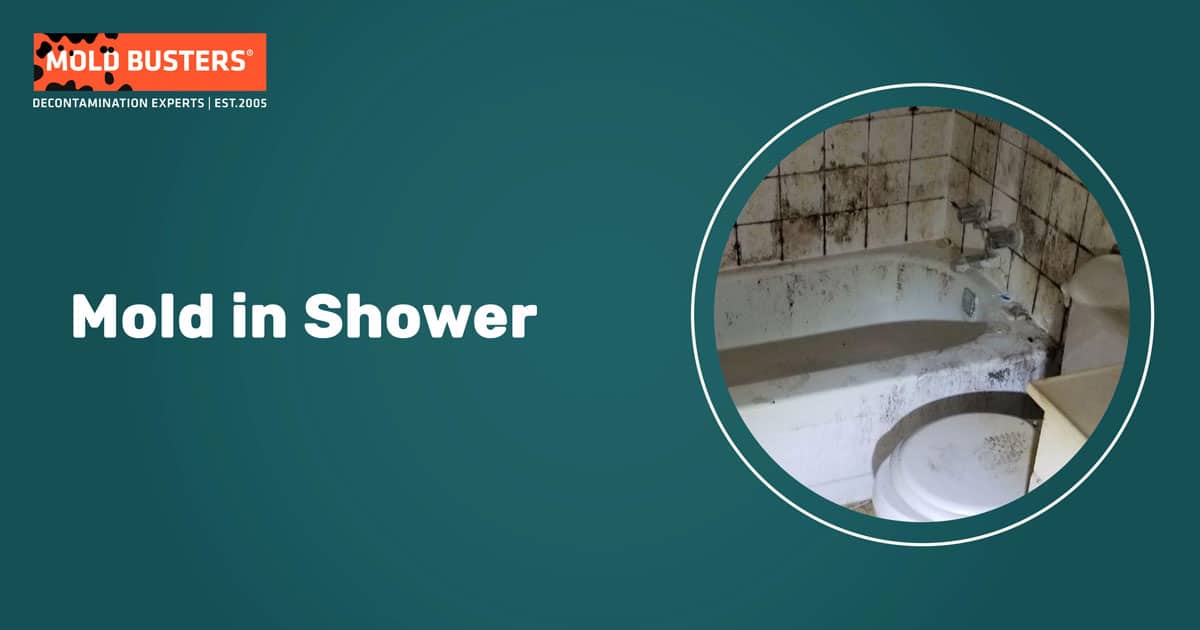
Showers and bathtubs are wonderful places for mold to grow. The high humidity, heat, and food sources provide mold spores a great environment to thrive in. Once established, the mold colony will continue to grow because of the perfect storm of conditions in the shower environment.
Mold in shower caulking
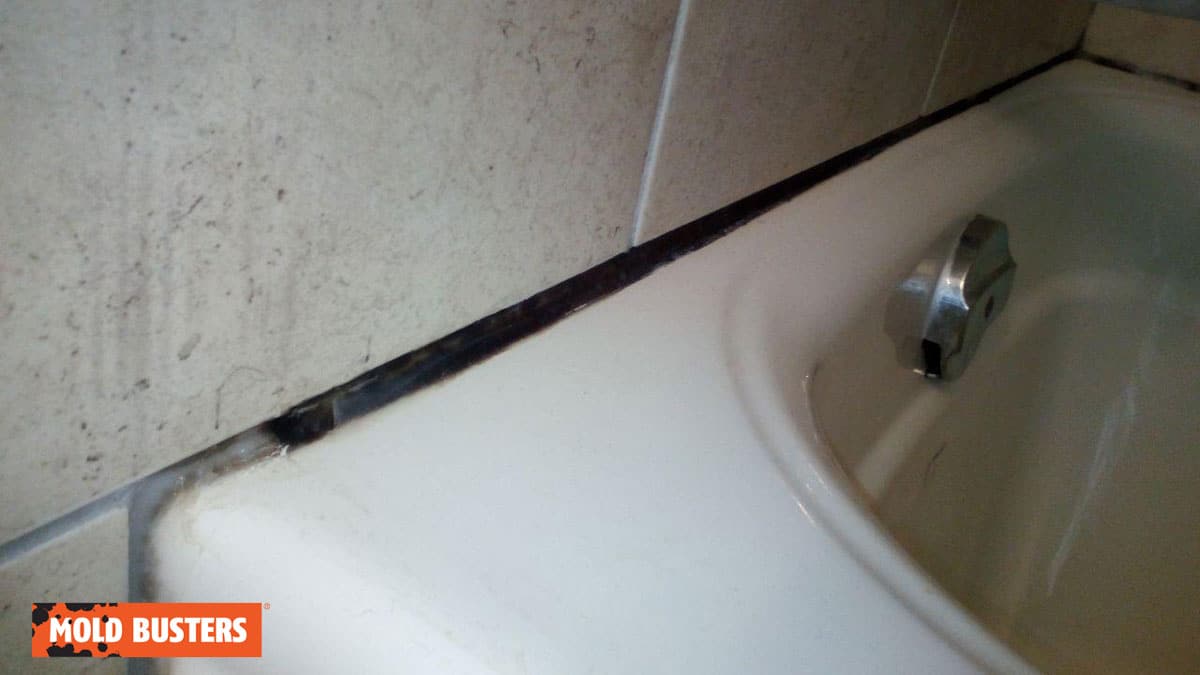
A great place for mold to grow is around the caulking of the tub and shower. Hair, soap, and other particles can get trapped in the edge of the caulking line creating a great environment for heat, moisture, and food for mold spores. It will grow easily along the caulking of bathtubs and showers if not cleaned regularly.
Mold on shower curtain
Shower curtains are ideal items for mold to grow on. Soap particles get stuck on the shower curtain over time, creating a food source. The mold will attach itself to the curtain material and colonize easily. The water from the shower is not enough to remove the colony; it only creates air and water movement to grow the mold over a larger area. To keep mold at bay on the shower curtain, remove it and wash it regularly in the washing machine and keep it dry after use.
Mold on bathroom ceiling above shower
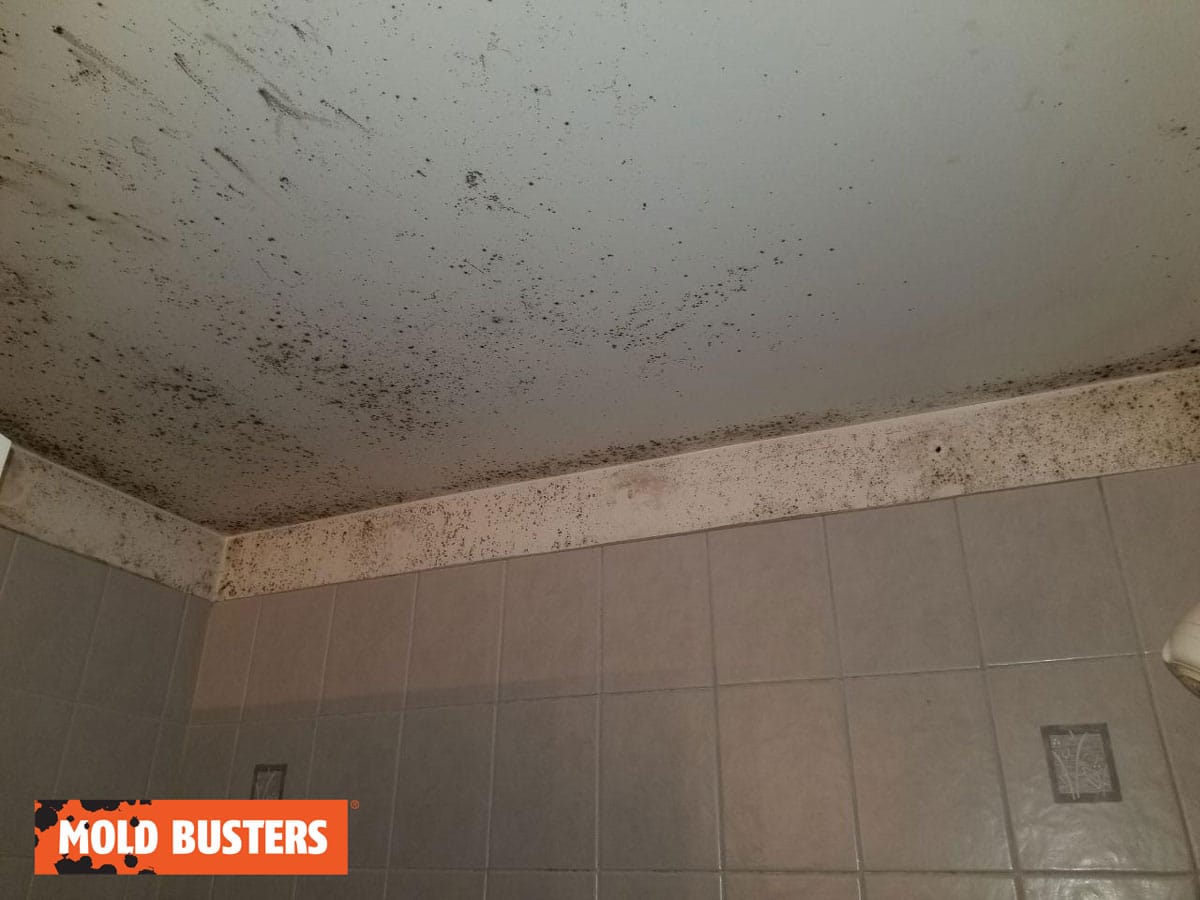
The ceiling of a bathroom takes a lot of abuse if there is insufficient ventilation from the bathroom fan. As a result, the steam created from the shower and bath rises and makes the ceiling damp as heat and steam rise as it is produced. This creates an ideal environment for mold to colonize and grow. The mold spores will attach themselves to the ceiling and grow every time the steam gets damp. The dust from everyday living provides a great food source for mold on the ceiling of the shower and bathroom, and the steam and heat will kick growth into high gear. The best way to ensure that mold does not grow on the ceiling of a bathroom or shower is to provide adequate ventilation with a bathroom exhaust fan with the correct CFM for the size of your bathroom. This will ensure the least amount of steam and moisture buildup inside the bathroom.
Mold on showerhead
Sometimes showerheads themselves have little crevices and designs on them, and dirt can gather in these indents causing mold to grow around them. This can be cleaned up by using a bowl with some CLR-type cleaning product to remove the shower scum building up on the showerhead and clean any nooks and indents in the showerhead design and keep them clean, so they do not promote mold growth. Again, like most places in the bathroom, keeping items clean regularly will go a long way to keeping mold growth to a minimum.
Mold behind shower tiles
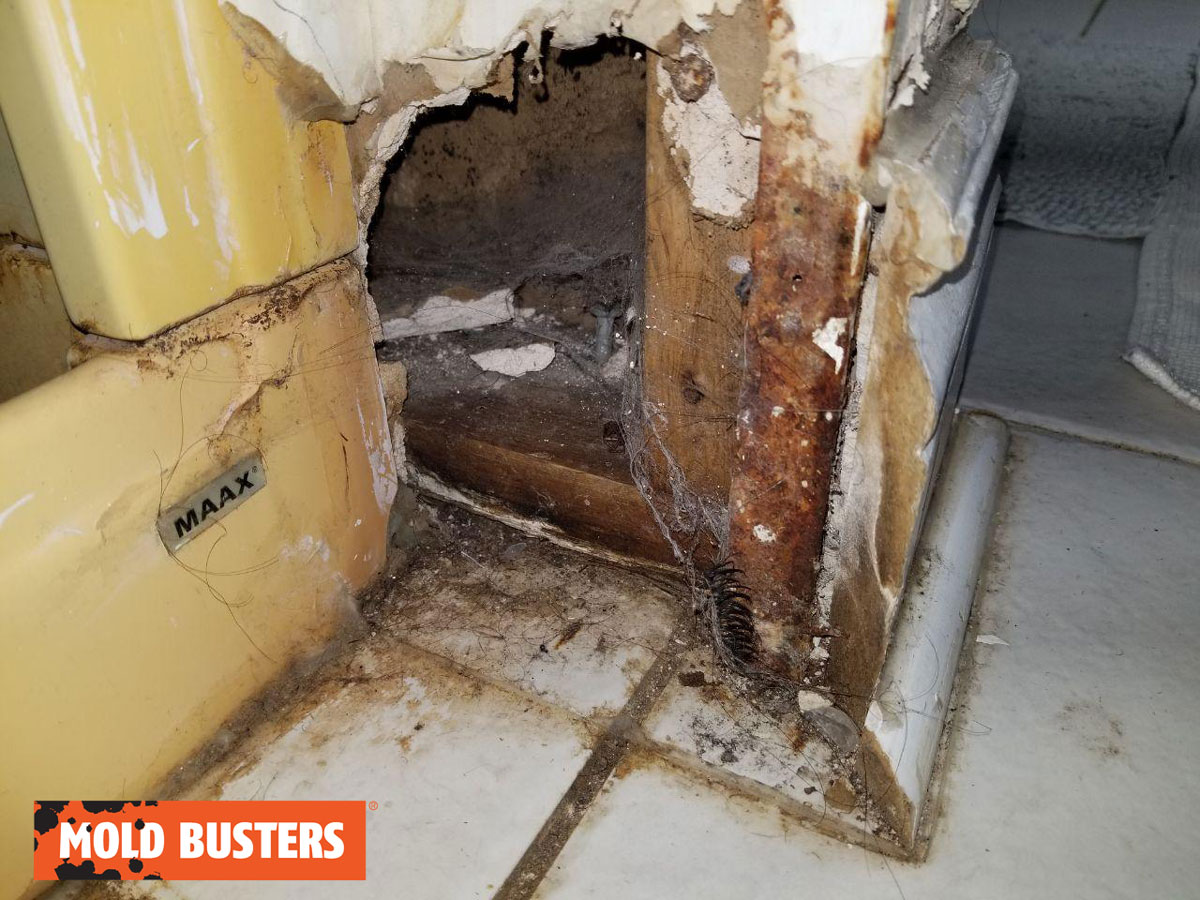
Mold growing on the outside of the tiles and grout of a shower and/or bathtub enclosure could be a tell-tale sign of larger issues. Most times, mold growing on the outside of the tiles indicates water infiltration behind the tiles, and a large mold colony is growing behind the tiles. If you clean the tiles regularly and start to see growth patterns on the tile in the same place every time, it may indicate water getting behind the tiles and creating a more significant issue to deal with. At this point, you will need to call a Mold Busters professional to come to your home and do a complete inspection to make sure you do not have a large mold issue. If you do, they will adequately remove the mold from behind your shower and make sure that mold does not start to regrow behind the tiles again.
You can also consider our virtual inspection services for a quick and convenient assessment.
Mold in shower drain
A shower drain is an ideal place for mold to grow. There are ample food sources in the form of dead skin cells, hair, soap, and shampoo scum, and other food sources that will fuel mold growth. Hot water going down the drain will promote mold growth with nice warm moisture content to quickly grow mold. Cleaning the shower drain once again will keep mold from growing; however, it can get beyond the point of regular cleaning where an inspection and remediation could be needed for proper removal.
Mold between shower glass
Some shower doors are laminated, meaning two pieces of glass are put together to create a steam-proof glass. Sometimes the adhesive between the two panes of glass breaks down, and moisture can get in between the glass halves. Mold can grow inside these panes of glass, creating a colony that traditional methods cannot clean. If you have mold growing between the glass of a shower door or enclosure, the only remediation would be to replace the glass. Leaving the glass in place can cause the mold to spread to other areas of the bathroom or home as it can still be moved by air currents in the room very easily. An inspection by a Mold Busters professional will ensure you have the right information on what is growing between the glass in your shower.
Types of mold that can grow in your shower
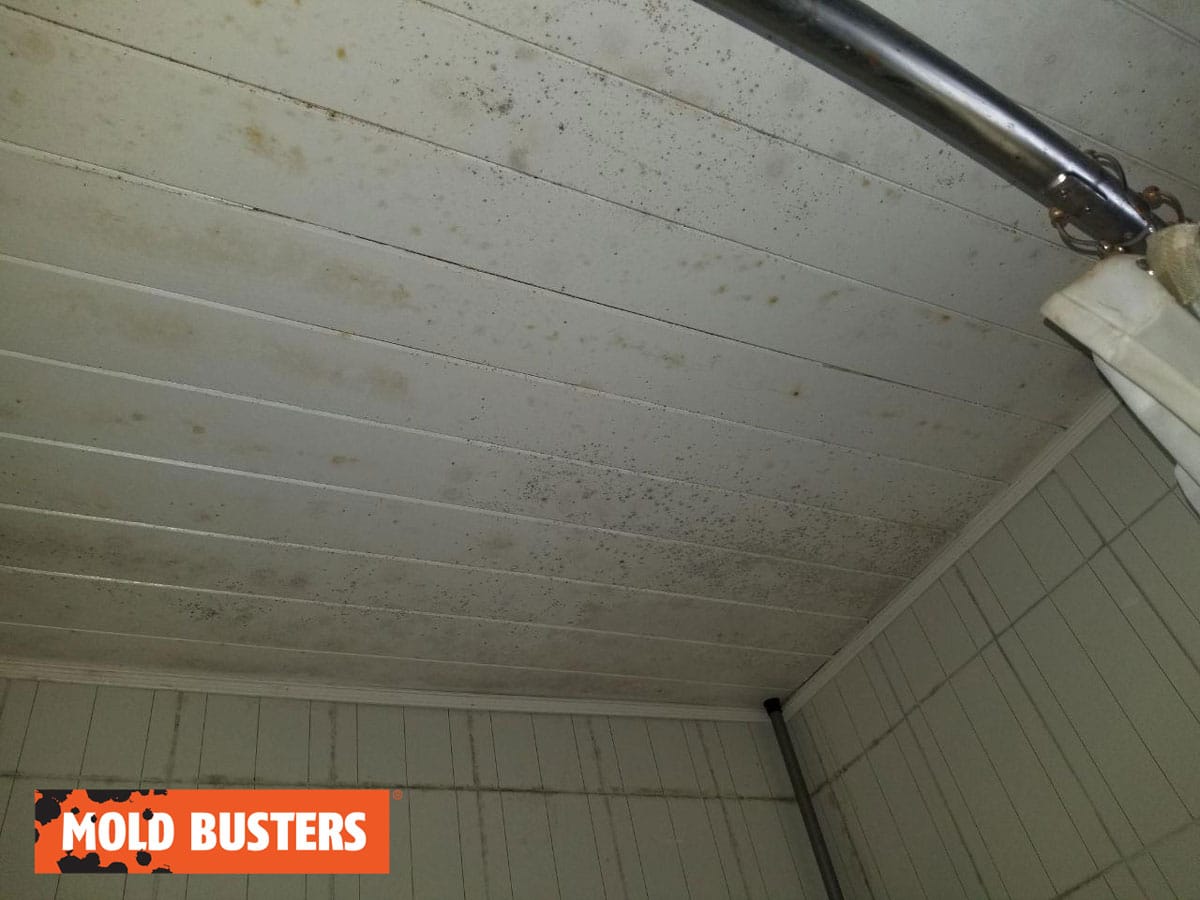
Orange mold in shower
Orange mold is not usually a single type of mold but rather a group of mold species growing together. It will take on the visual of small little spots growing first, and if left untreated, it turns into a slimy growth as it grows and multiplies. It is usually not life-threatening, but it can damage various structures in your home and lower your property values.
Pink mold in shower
Pink mold is usually not a mold but rather a bacterium that attaches itself to white or grey colored molds. It starts as a fuzzy, fibrous growth; then, the bacteria grow on the mold growth. It can take on various shapes when it grows, and it also will turn into a slimy growth once the colony grows large enough. Pink mold has numerous health implications, including the following.
- Allergic reactions include coughing, sneezing, breaking out in rashes, and more.
- Respiratory issues and difficulty breathing.
- Pneumonia can be triggered by pink mold.
- If ingested in large enough quantities, pink mold can make you very ill.
Red mold in shower
Red mold is a common mold to grow in bathrooms and showers. Red mold is not just one species of mold as many common mold types have a reddish appearance as it grows. Therefore, it is important to see red growths forming even after you wipe down your shower and bathtub areas. Red mold colonies can also grow under sinks, around toilet drains, and other places. A tell-tale sign of red mold growth is the “musty” smell regularly noticed during mold infestations. Red mold is not commonly dangerous to healthy adults, but it could seriously impact children, adults with auto-immune issues or asthma-type conditions.
Black mold in shower
One of the most talked-about mold growths is black mold. Commonly called “toxic black mold” in the media, this mold is one of the more common mold growths that form in your bathroom and showers. This mold likes damp places like showers, sinks, and bathrooms. The black mold colonies look like black or dark green circular growths and grow quickly in proper conditions. They release the typical musty smell that accompanies mold growths. Black mold can create many health issues if you are exposed regularly to it. Various respiratory issues such as wheezing, coughing, and difficulty breathing are common to black mold exposure. Other issues such as watery, itching eyes, and rashes are common from exposure as well.
Is mold in the shower dangerous?
As with any mold colony, it can create many health issues for you and your family. Mold in the shower can increase the exposure as it is normally damp with lots of air movement inside the shower and bathroom, creating a great environment for mold to spread. As mentioned previously, health issues from mold can range from respiratory and breathing issues to allergic reactions, including rashes, watery, itchy eyes, and hives. Other health issues include stomach issues, headaches, dizziness, and difficulty concentrating. If you have any of these symptoms and you do not know what is triggering them, contact Mold Busters right away to book a whole home inspection to ensure your home is safe and healthy.
We have dedicated teams in Montreal and Ottawa ready to assist you.
How to identify mold in the shower?
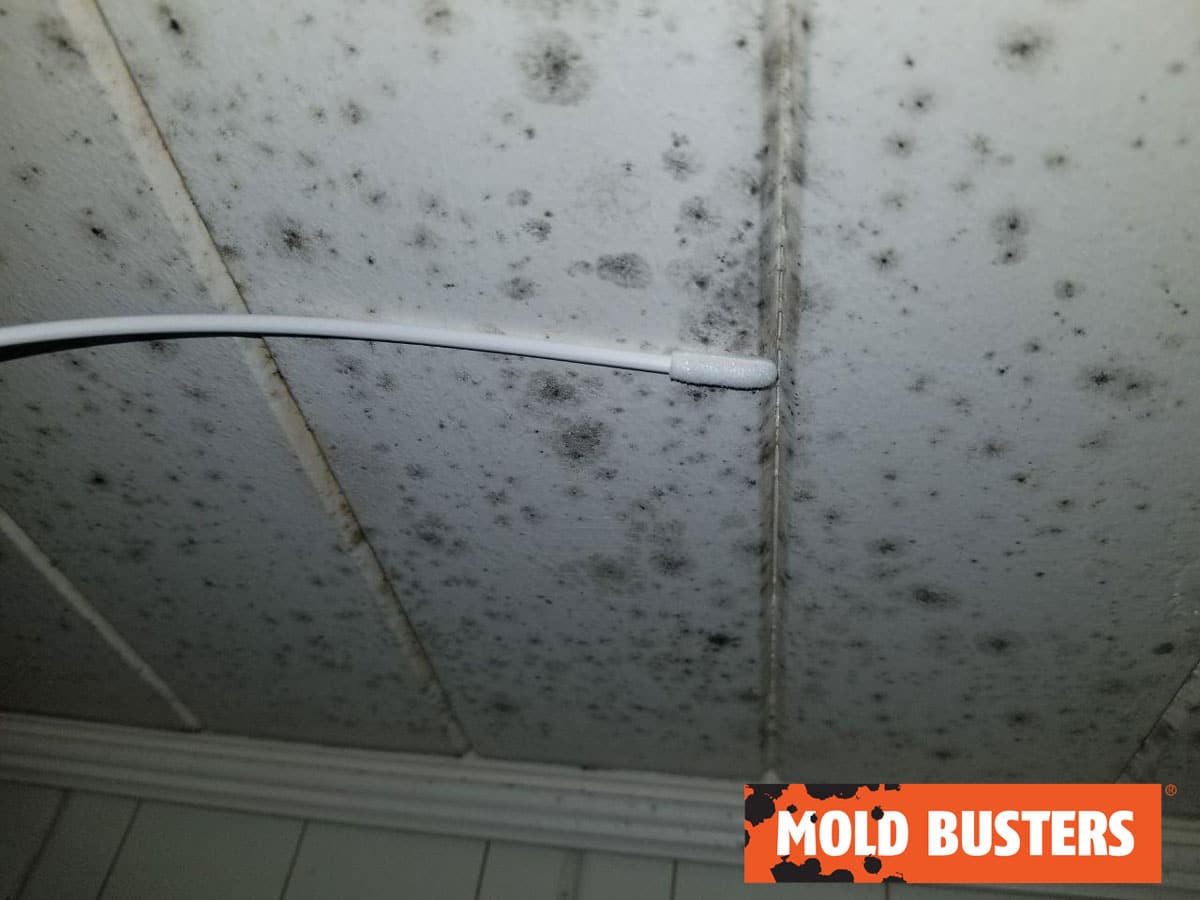
If you think you could have mold growing in your shower or bathroom, the safest thing to do is contact Mold Busters, and they will send a trained professional to your home to properly test to see if you do have mold growing. For more information on identifying mold inside your home and how to properly test for it, please visit our mold testing services. This will give you the best information on testing and why you should leave mold contact to the professionals at Mold Busters.
How to prevent mold growth in the shower?
Preventing mold in the shower is relatively simple. You need to cut out moisture and food sources for the mold spores. After finishing your shower, you should wipe down all surfaces to dry them off so that you cut off one of the three important conditions needed for mold to grow, which would be moisture. Every three or four days, you should clean the shower using a disinfectant cleaner to prevent the buildup of various food sources for mold spores. Doing both will cut down on the chances of mold growing by a significant amount. Sometimes, the mold is growing in places you cannot easily access to prevent it. Places such as a failing grout line in the tile allow water in behind the tiles.
How to get rid of mold in the shower?
As with any place, mold is growing, removing the mold yourself could be dangerous to your health. Mold can be transmitted throughout your home if you are not properly trained on how to remediate it. The best thing you can do as a homeowner is to contact Mold Busters in your area so that a professional can properly identify and remove the mold from your home using the proper equipment and techniques they are trained to use.
Frequently asked questions
How do I properly clean mold buildup in a shower?
Cleaning mold in your shower really should be left to the professionals. Mold Busters have been in business for over 19 years and have fully trained professional inspectors and remediators on staff to ensure your mold issues are handled correctly. When it comes to mold, the best policy is to call Mold Busters to remove it.
What is the best cleaner for mold in my shower?
The best cleaner to prevent mold would be any number of antibacterial bathroom cleaners on the market, and they will prevent mold from growing in the first place. If you currently have mold growing inside your shower, do not try to clean it off, as you will only start spreading the mold spores throughout your home. Mold spores are extremely light, and the slightest air currents can spread them over long distances.
How do I remove mold from the caulking in my shower?
If there is a minimal amount of mold or mildew on the caulking inside the shower, you can remove the caulking, put it into a well-sealed bag and take it outside your home. Then proceed to apply a new caulking seal to the shower. Ensure you are creating a fully waterproof seal as you apply the new caulking. If there is more than a minimal amount of mold growth, contact Mold Busters to have a professional visit and provide the correct procedures to remove the mold.

Get Special Gift: Industry-Standard Mold Removal Guidelines
Download the industry-standard guidelines that Mold Busters use in their own mold removal services, including news, tips and special offers:
"*" indicates required fields
Published: March 7, 2022 Updated: June 10, 2024

Written by:
Steven Adams
AMRT, WRT, ASD
Mold Busters
Fact checked by:
Michael Golubev
CEO
Mold Busters
